"Neurodiversity through Webcomics: Using Aesthetic Experiences for Epistemic Resistance"
At the heart of the ideas proposed in today's panel is that of epistemic enablement through trajectories other than propositional, which can be offered by aesthetic experience.
PANEL
"Dancing Toward Epistemic Justice: An Embodied Account of Epistemic Agency"
Amandine Catala and Camille Zimmermann covered the example of dance, an embodied account of epistemic enablement.
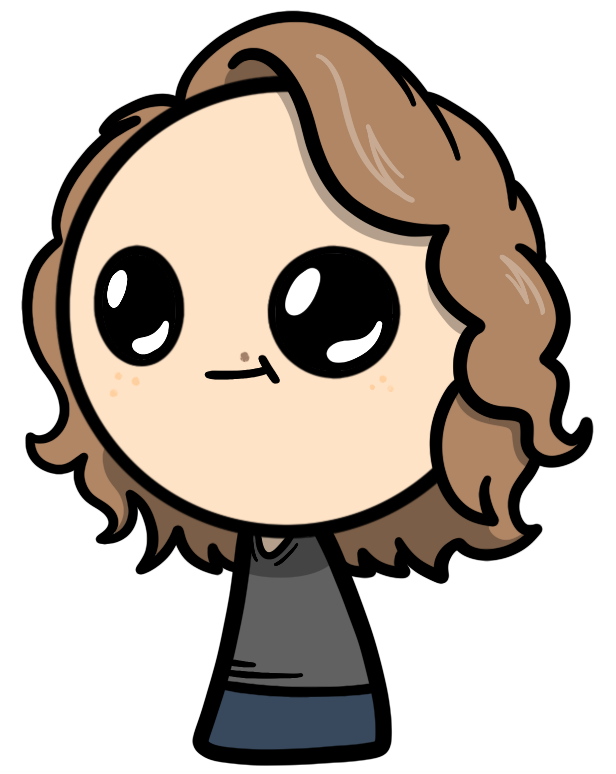
PhD Candidate - Philosophy (UQAM)
Camille Zimmermann
zimmermann.camille@courrier.uqam.ca

Professor - Philosophy (UQAM)
Amandine Catala
catala.amandine@uqam.ca
"Comics and Epistemic Enablement"
Luc Faucher discussed the medium of comics in the context of neurodiversity, again as epistemic enablement.
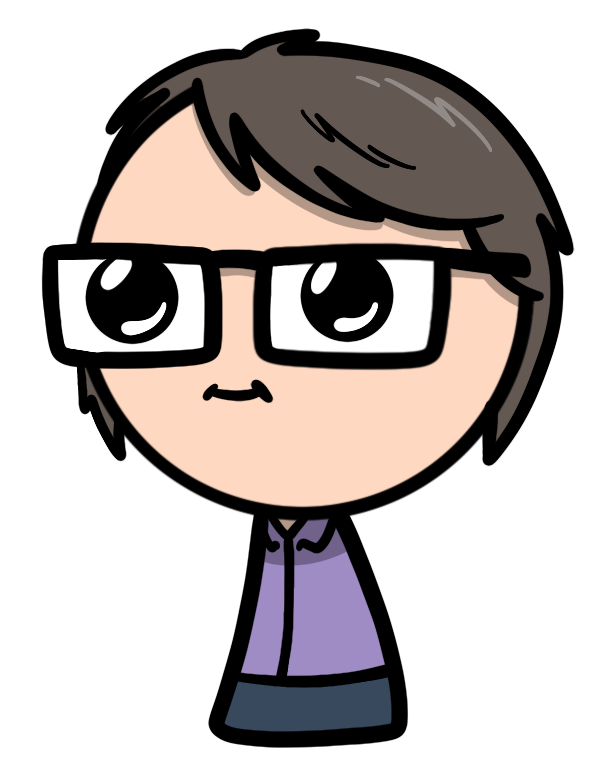
Professor - Philosophy (UQAM)
Luc Faucher
"Neurodiversity through Webcomics: Using Aesthetic Experiences for Epistemic Resistance"
We now continue with webcomics.
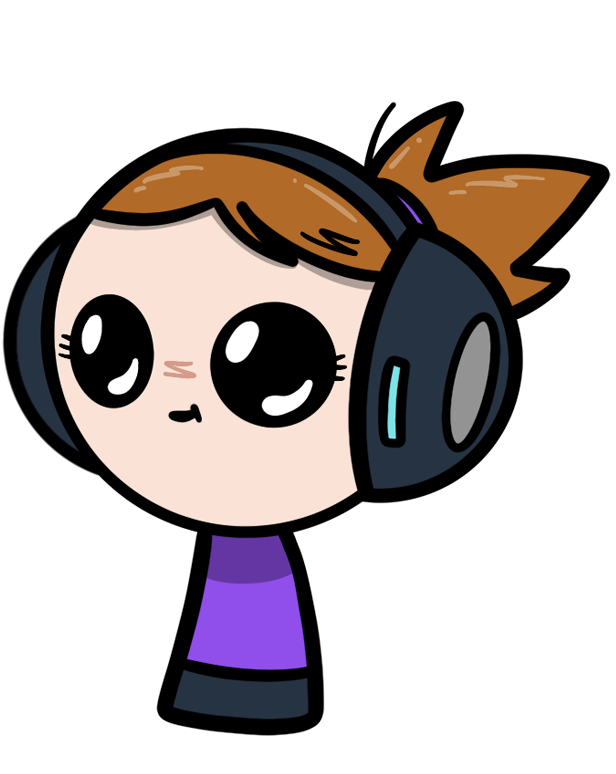
PhD Candidate - Philosophy (UQAM)
Mylène Legault
legault.mylene.2@courrier.uqam.ca

PhD Candidate - Philosophy (UQAM)
Jean-Nicolas Bourdon
bourdon.jean-nicolas@courrier.uqam.ca
PREFACE
About the
Format
Force of habit leads us to take the established ways of doing things as fixed, even though they are circumstantial. We were able to explore this reality, for example, during the pandemic: going to the office for work meetings, which, in all honesty, could have been e-mails. We also know that cultural habits are not insignificant, they allow the reproduction of comfortable modalities of interaction for dominant groups: those with the power to choose these modalities.
For our part of the panel, we propose to do things differently. Don't worry, we're not criticizing power point presentations and their timely sip of water pauses. Instead, we're inviting you to explore an alternative modality for interaction.
Public Speaking
Many people hate public speaking. It generally comes with discomforts and even fears, but some people have cognitive profiles that function in ways far removed from this type of interaction. However, this practice is socially maintained and considered essential for meeting and sharing. But is it really necessary? Does the public space absolutely have to be occupied in an oratory and synchronous way? What if these modalities are, in fact, infused with neuronormativity?
Human society is permeated by collective cultural resources with which individuals can, among other things, interpret, understand and communicate various aspects of their experiences. Since they are collective resources, their genesis, maintenance and dissemination are a function of the power dynamics that permeate our societies. One of these power dynamics is organized around norms regarding what is considered appropriate cognitive functioning: the group whose cognition corresponds to the norm (i.e., neurotypicals) dominates and those whose cognition deviates from the norm (i.e., neurodivergent) are marginalized. This epistemic marginalization has the effect of limiting the access of neurodivergent individuals to so-called "collective" epistemic resources, both in their elaboration and in their use.
This norm corresponds to neuronormativity, which is presented by Amandine Catala, Luc Faucher et Pierre Poirier (2021) in their paper Autism, epistemic injustice, and epistemic disablement: a relational account of epistemic agency.
Neuronormativity refers to the prevalent, neurotypical set of assumptions, norms, and practices that construes neurotypicality as the sole acceptable or superior mode of cognition, and that stigmatizes attitudes, behaviors, or actions that reflect neu- roatypical modes of cognition as deviant or inferior. Neuronormative assumptions, norms, and practices uphold standards regarding, for example, (what is neurotypi- cally considered) appropriate eye contact, facial expressions, prosody, conversa- tional flow, processing, and responsiveness—all of which can be difficult for autistic individuals to understand, sense, or apply, due to neurocognitive differences. (Catala & al., 2021)
Catala, A., Faucher, L. & Poirier, P. Autism, epistemic injustice, and epistemic disablement: a relational account of epistemic agency. Synthese (2021).
For a presentation on these questions, see Epistemic justice and epistemic authority on autism, Philosophy of Psychiatry Webinar, Montreal (Amandine Catala)
What’s with all these neuro- words?
Neurodiversity can refer to the neurological or neurocognitive variation naturally present in the human population. The term was first introduced by Judy Singer in a book published in 1993. The term also refers to a growing sociopolitical movement that promotes the recognition and inclusion of natural neurocognitive diversity (see, for example, Autistic Self Advocacy Network (ASAN), whose slogan is "Nothing About Us Without US!").
Nick Walker (2012) describes the neurodiversity movement as a new paradigm (the neurodiversity paradigm) in response to the pathology paradigm. It should be noted, however, that this movement has not been and is not immune to certain exclusionary mechanisms. For example, the movement began with verbal autistic individuals, but although the movement has since expanded to include many cognitive profiles, autistic individuals (and more recently ADHD individuals) still seem to dominate the movement.
Walker, N. (2012). Throw away the master's tools: Liberating ourselves from the pathology paradigm. Loud hands: Autistic people, speaking, 225-237.
Some progress can also be noted with the recent publication of "Neurodiversity Studies: A New Critical Paradigm" (Rosqvist et al., 2020), which illustrates the growing acceptance of this sociopolitical movement by the scientific community.
Rosqvist, H. B., Chown, N., & Stenning, A. (2020). Neurodiversity Studies: A New Critical Paradigm. Routledge.
Refers to individuals who fit the norm of cognitive functioning.
Neurodivergence belongs to a normative vocabulary. It requires a norm, which can be qualitative or quantitative, to distinguish typical from atypical neurocognitive profiles among natural neurological variation. However, the narrative is not so simple; cognition is a complex and dynamic process, and simply distinguishing between neurotypical and neuroatypical individuals shapes, at least in part, the cognition of those same individuals. Note that these criteria, quantitative or qualitative, are generally chosen for medical, practical, economic or moral reasons: because a type is considered "more functional", "more adapted, evolutionarily", "easier to interact with", "less demanding in resources" more characteristic of a human life worth living", etc.
Refers to individuals who do not fit the norm for cognitive functioning.
For those who are curious, we address these "neuro- words" here :
- Legault, M., Bourdon, J. & Poirier, P. (2021). From neurodiversity to neurodivergence by way of epistemic marginalization, Epistemological Issues in Neurodivergence and Atypical Cognition. Synthese.
- Legault, M., Bourdon, J. & Poirier, P. (2019) Neurocognitive variety in neurotypical environments: the source of “deficits” in autism, Journal of Behavioral and Brain Science (JBBS), vol.9, 246-272.
This is all well and good in theory, but what does it have to do with our presentation?
What we are trying to say - probably with too many words - is that those with cognitive profiles similar to ours tend to feel unsafe in traditional academic frameworks. This very presentation is the perfect opportunity to experiment with an alternative format where we can occupy the epistemic space and exist as we are. When the parameters of a common space of exchange only correspond to one type of cognitive profile, neurotypical profiles in this case, there can hardly be any exchange that is fair and inclusive. Our hope is that offering this alternative might open this type of space to those who remain outside the exchange.
Although this is an aside before we get into our main topic, you will notice that the form of our presentation reproduces our subject: the online viewing of webcomics, that is, asynchronous interactions around a shared representation, or the infamous content.
What a great question! Of course. If we have different cognitive and processing profiles with different modalities of expression, we can expect adjustments in synchronicity. Strategies for better epistemic justice include suspending judgment, giving the time, respecting varied forms of exchange and being open to different modalities of exchange.
Feel free to contact us for any comments and input into this exploration:
legault.mylene.2@courrier.uqam.ca
bourdon.jean-nicolas@courrier.uqam.ca
PART I
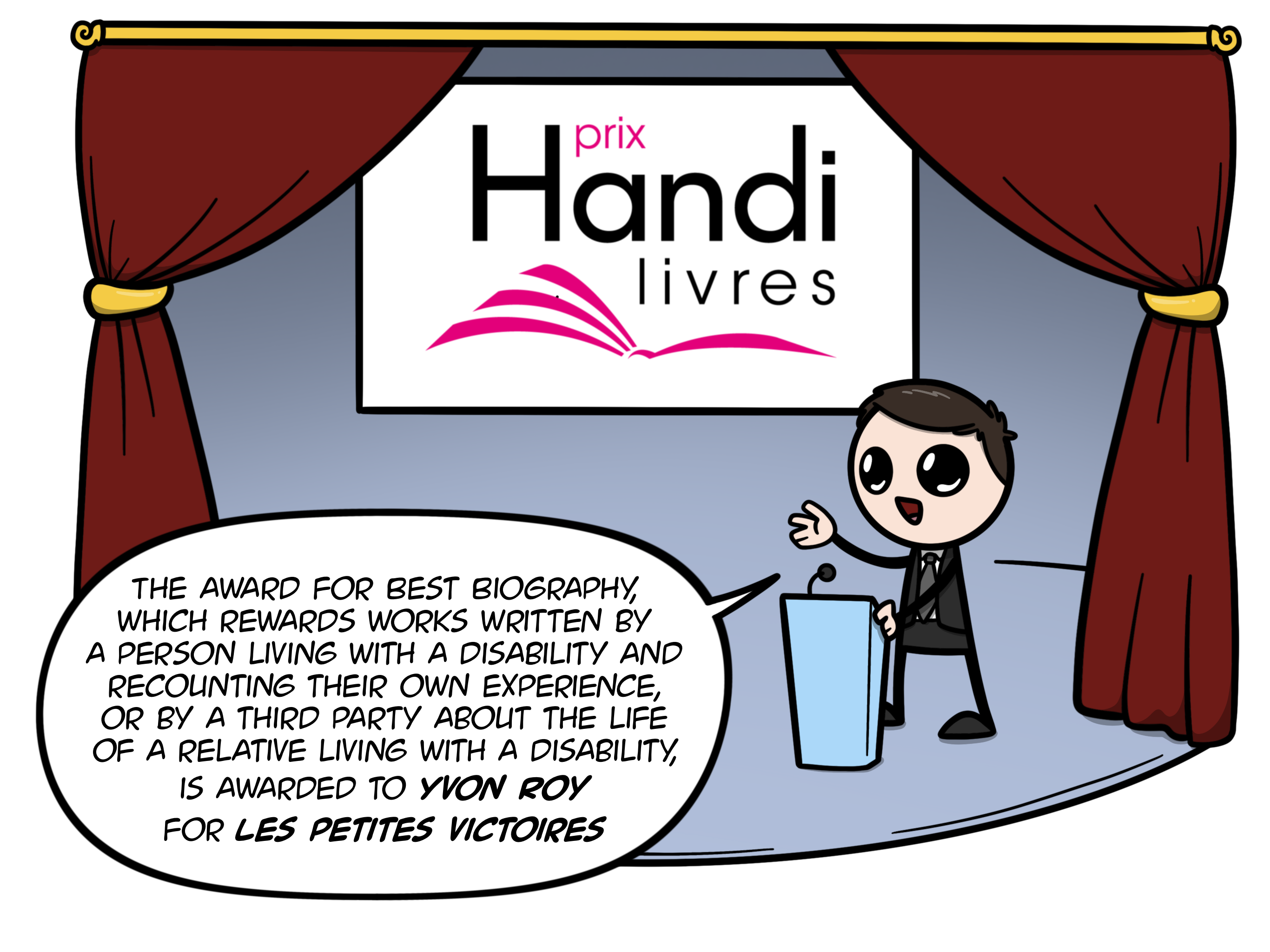
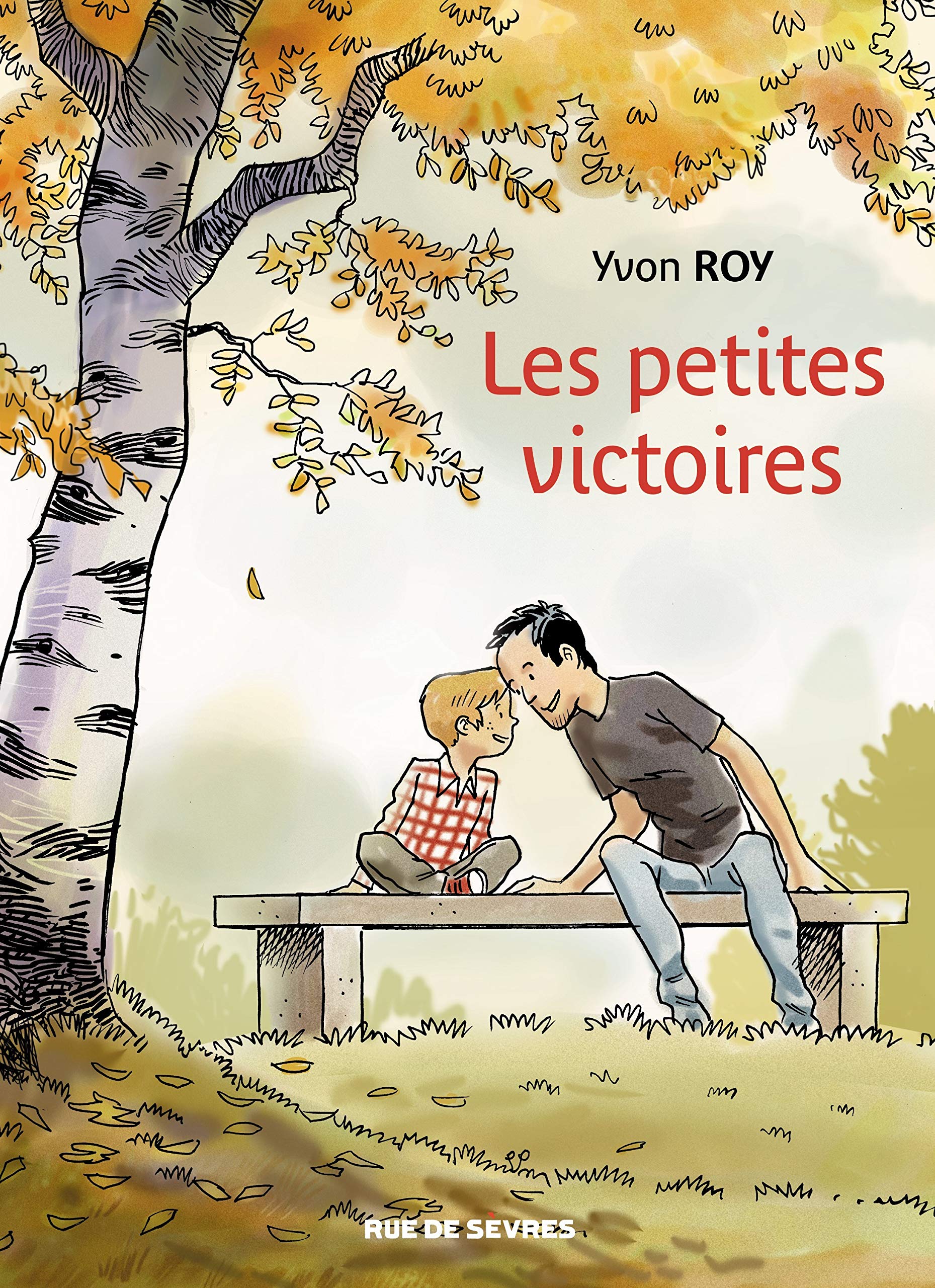
This is Marc, stand in for the author: Yvon Roy
This is his son, Olivier, who is autistic.
Les Petites Victoires showcases the fight of a father for his son, diagnosed with autism "in order to transform an announced defeat into small victories" (sic, our translation).
In his preface, Roy explains the contextualises the creation of his comic book:
"The idea was first suggested to me by a special educator who had worked with my son. She thought that what we had accomplished together was worth sharing so that other parents could find, through our experience, some useful information, if not a little hope" (our translation).
Interview
"When I started working with my boy to help him, with all the professionals in the field, I realized that often we were told, or they tried to tell us, that we had to work on living with autism, on accommodating autism. How we had to deal with different crises, different problems, whereas I thought, well, no, it's better, definitely, to try to overcome it than to live with it. And that's been kind of my master idea, let's say, for years with my boy, which is to try to push the boundaries constantly, always further." (Our translation)
Why choose this comic book?
This comic book is an example of a creation that is easily accessible to the general public that has been awarded and highly publicized - even winning an award that recognizes works written by a person living with a disability and recounting their own experience, or by a third party about the life of a relative living with a disability. In 2018, the publisher Rue de Sèvres announced a contract for a film adaptation, which caused reactions and led to the hashtag :
#boycottlespetitesvictoires
As we will show, this is an example of the social representations of autism that perpetuate dominant understandings that do not fit the lived experience of those directly concerned to the point of being discriminatory. It is also difficult to identify moments when the child (the autistic character) shows agentivity. Instead, he’s passive in his father’s story. In a way, Olivier is only a supporting character. This is exaclty why representation doesn't mean autorepresentation and why "nothing about us whitout us" matters: although this comic is presented as a positive narrative from the allist perspective (3rd person), the story is completely different from the standpoint of the autistic community’s testimonies (1st person).
An allist person is a non-autistic person.
To understand the term "allist", we must go back to the origin of the word "autistic" which comes from the Greek word "autos" which means "self". So the word "autistic" initially referred to a person withdrawn on themself, who lives in their own world. The term "allist" appeared in a satirical article to refer to non-autistic people by swaping “autos” for "allos" which refers to others. So an allist is a person who is focused on others or, to flip the usual narrative, a person who lives in other people’s worlds.
In spite of the satire, the term “allist” has remained in use among others because it allows to distinguish between "neurotypicals" and "allists". There are people who are not autistic, but who are not neurotypical: a non-autistic dyslexic person, for example.
For a deconstruction
of the problematic propositions of the comic book:
But do you know the story from the autistic community’s perspective?
This is where webcomics can serve as an accessible tool that allows the reversal of dominant representations by opening the floor to self-representations directly grounded in marginalized communities. But before continuing with the topic of webcomics, we wish to feature an excerpt from Les Petites Victoires that addresses a frequent theme in autism: eye contact.
Excerpt on eye contact
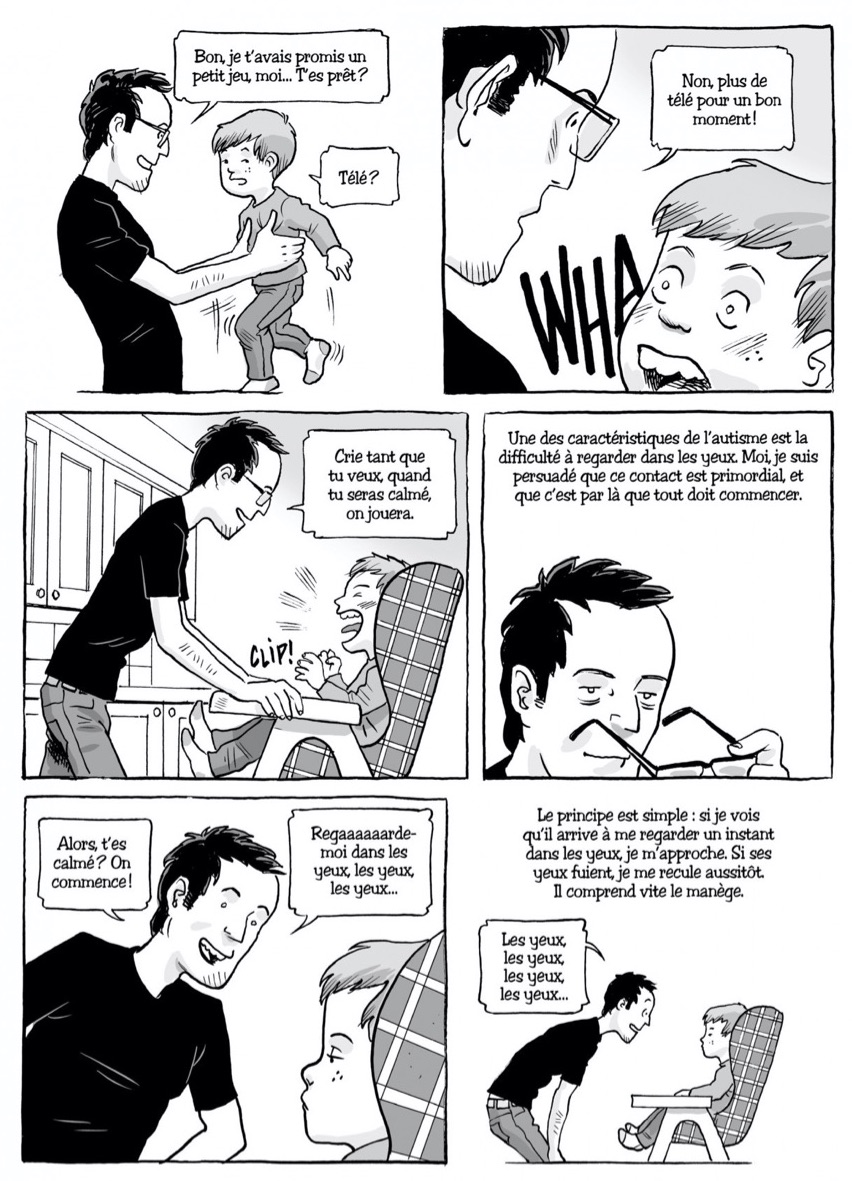
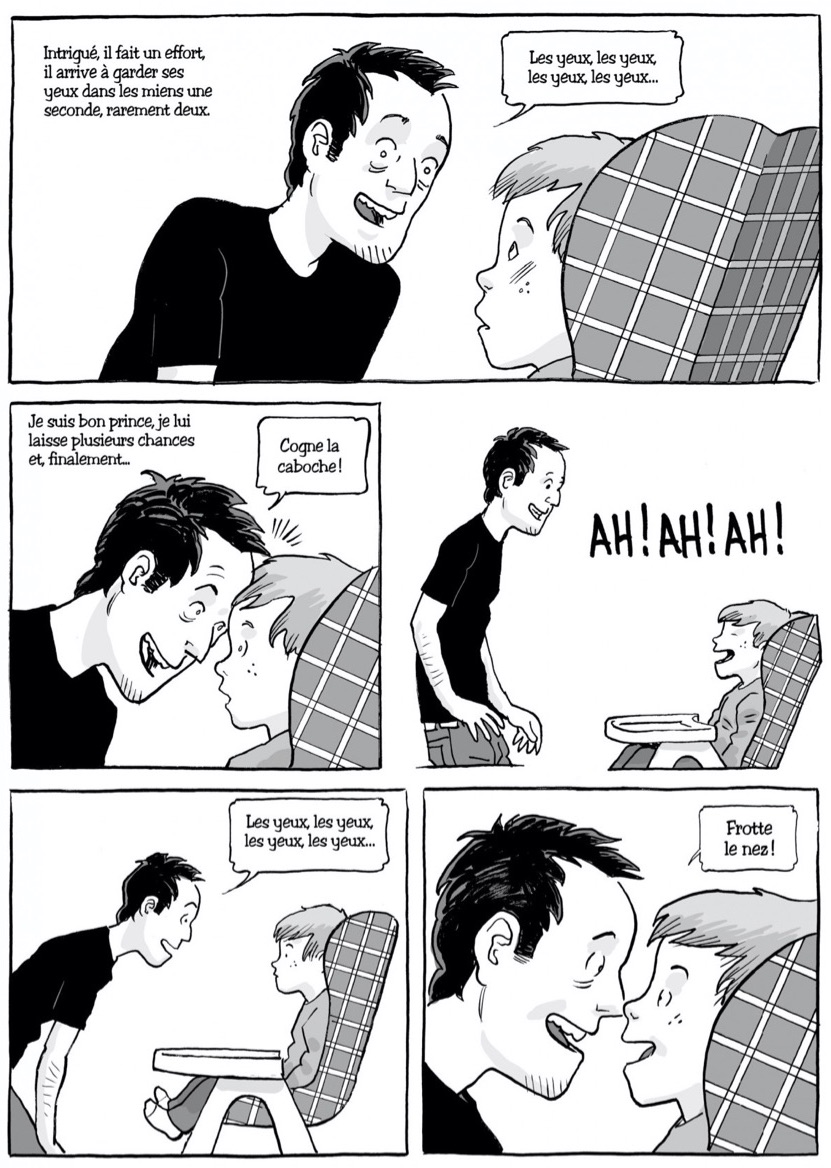
Excerpt from Yvon Roy's interview
"I worked a bit like we can work to sometimes desensitize a substance. Sometimes certain people can have an allergy, we can try to desensitize them.
Several parents have contacted me regarding the trick to get the child to look in the eyes. This is the first thing we worked on together, that is to say, I considered that being able to look in the eyes - we know that autistic children have difficulty looking directly in the eyes - I said to myself, if we don't have eye contact, we have nothing. We need that, it's the beginning of human interaction." (our translation)
TW: The host uses the term “prison” in reference to autism:
"In your story that you shared with us in Les Petites Victoires, there is obviously the moment when you get up to face, to accompany your child in that reality: to learn to understand him too, inside what he lives and this prison, in a way, from which he is pressured which is basically this condition." (our translation)
Link to the interview (in French)
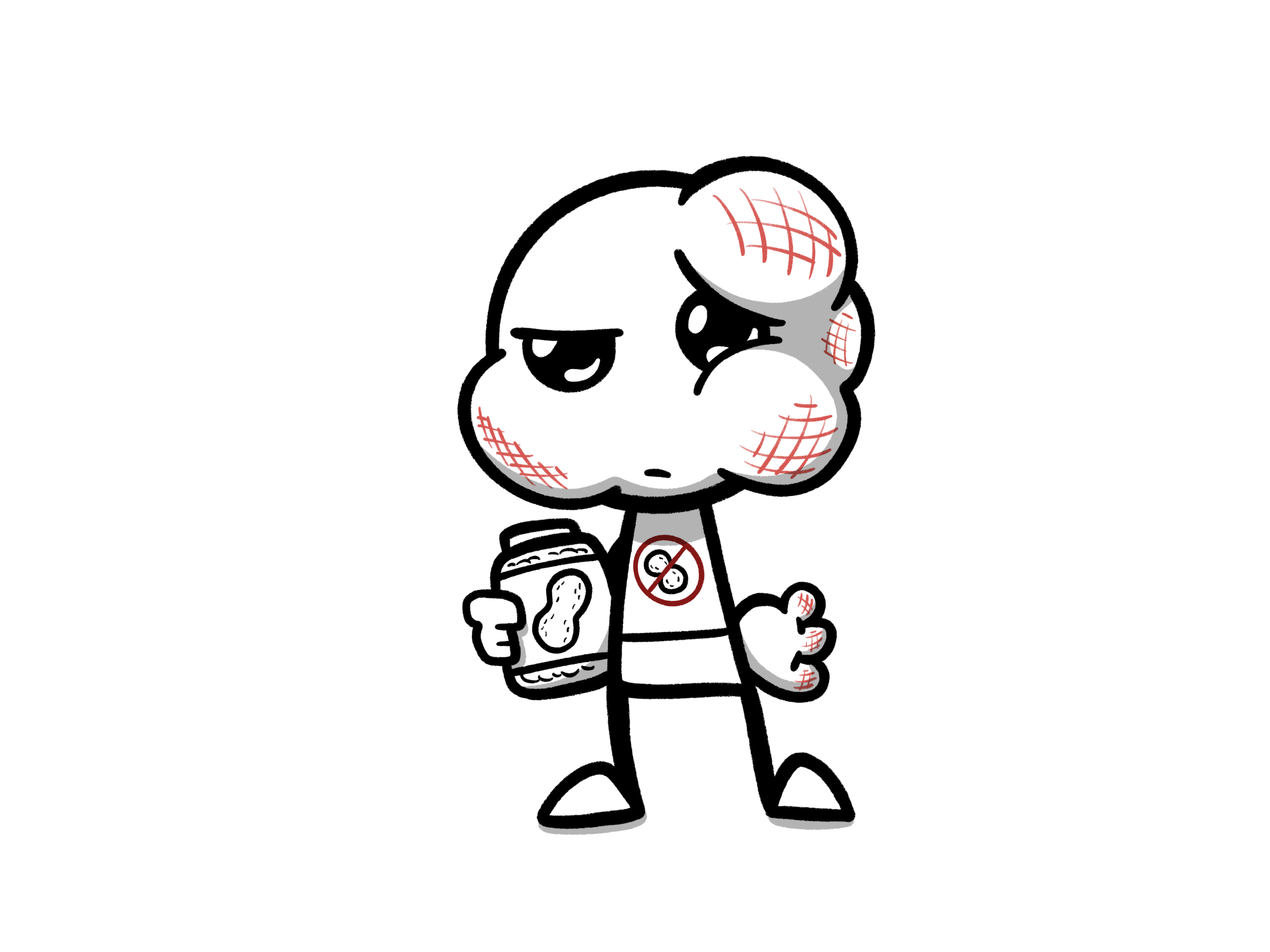

This scene is an example of neuronormativity
Recall that neuronormativity is the prevalent, neurotypical set of assumptions, norms, and practices that conceives of neurotypicality as the only acceptable or superior mode of cognition, and that stigmatizes attitudes, behaviors, or actions that reflect atypical modes of cognition as deviant or inferior.
This scene is told from the allist perspective and is presented with a positive outcome. In fact, as the author mentions, parents have applied this technique with their autistic children after being inspired by it.
But what if we ask autistic people how they feel about eye contact? That's exactly what we are going to do.
PART II

Why webcomics?
The medium of webcomic enables me to do something I don't know how to do otherwise: share how things feel on the inside.
Imagine. You come across a newspaper at the local coffee shop and recognize the face of a well-known personality. Yet you can't remember their name. It annoys you, you know you know it, it’s just not coming out, it stays there, on the tip of your tongue. You have time to come back to work, coffee in hand, and the name still hasn't come back to you, it still annoys you. You come across a colleague and you ask them, you describe the person, maybe clumsily at first (it would be so much easier with their name!), but you adjust to your interlocutor and, together, you can finally recall their name, it was so obvious!
It’s important to emphasize this feeling of annoyance. We rarely take the time to mention this annoyance when talking about epistemic injustices. Yet it is there, and it can even be painful: how do we make sense, to use Fricker's classic example, of our experience of sexual harassment when the concept does not yet exist? How can we share the feeling that something is wrong? This is where community comes into play and it is why the idea of "by and for" matters more than, say, a criterion of simplicity might. This is addressed by feminist epistemologies: for example, Longino argues for pragmatic values in science such as diffusion of power (as the importance of making research programs accessible to the actors involved in the research).
The impact of inadequate social representations on neurodiversity cannot be fully resolved by the traditional narrative of epistemic oppression and justice: adding new vocabulary to collective epistemic resources is not a panacea (we already have the word "autism" for example). So it is not only words that are missing, but rich and diverse lived experiences are also missing from the pool of shared resources.
The problem is that what is missing, the hermeneutical gaps, are not automatically apparent: social representations created by and for the dominant groups inadequately fill the hermeneutical gaps of marginalized groups. To that effect, let us recall here the Handi-Livre prize for the best biography which rewards works written by a person with a disability and telling his or her own experience, or by a third party on the life of a close relative with a disability: In the case of Les Petites Victoires, the award went to the biography of an allistic (non-autistic) person talking about autism. These inadequate social representations are difficult to resist: they are constantly and persistently reproduced. It is even harder when you don't have the words to replace theirs. But do we really have to wait for the right words to share our experiences? This is where illustration can become an attention grabbing action like shouting: an action that does not need words. This is what we propose here: a form of non-propositional epistemic resistance in response to hermeneutic injustice.
Webcomics are basically online comic books. They are mostly instantiated as short comics that take many forms and cover many topics. The most common form of webcomic is probably the blog (sometimes autobiographical, sometimes entirely fictional, sometimes both). Because they are mostly published independently by their artists, webcomics are an art form that is not limited by institutionalized power dynamics such as publishing houses or art galleries.
But the most important thing for us here is that webcomics are able to generate aesthetic experiences that allow viewers to better understand different aspects of the lived experience of neurodivergent people despite the inadequacy of mainstream epistemic resources.
In some ways, webcomics are a digital version of street art.
Although limited to a given geographical space for street art and to a particular digital platform for webcomics, there is this common idea where it is not so much the public that goes to the creation as the creation that goes to the public. We are no longer in a reserved and predefined space like a museum, a bookstore, a gallery or even a library.
Although a recognized artist can make street art, it is more difficult for an artist who does not belong to a complex and influential network to access some places of diffusion such as an art gallery. Webcomic is thus added to the tools that allow the production, use and transmission of more accurate social representations, participating in the collective understandings of the oppressions suffered by epistemically marginalized groups. The public and interactional aspects of social media that support webcomics make them a catalyst for direct dialogue with (but also within and between) marginalized communities.
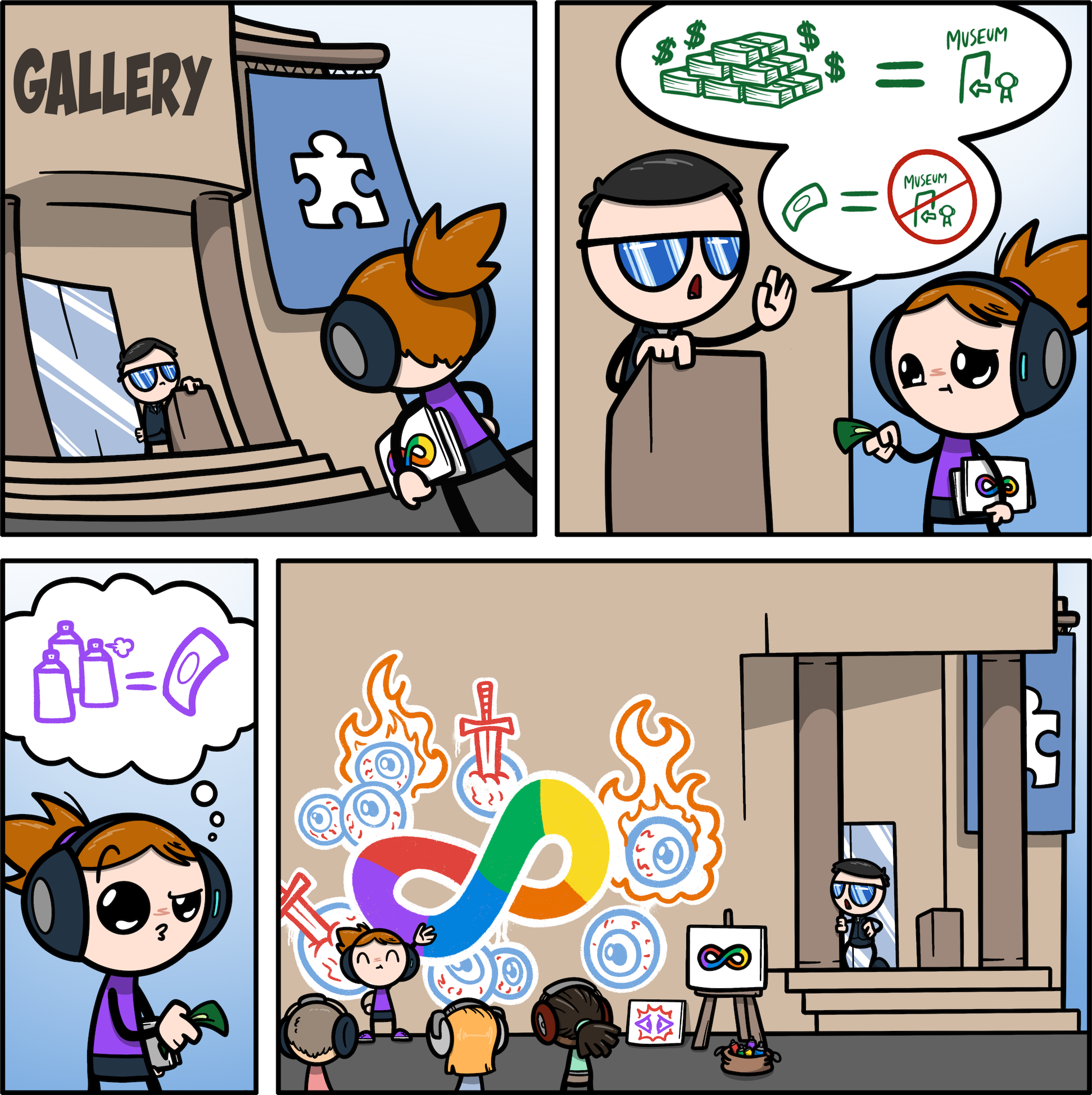
To put our epistemic resistance into action,
and to enhance our imaginative ressources, we chose to gather first-personal testimonies and descriptions of how eye contact can feel for autists.
After all, who better to provide insight into a given lived experience than those who live it? To do so, we used social media (instagram and facebook) to ask autistic followers of our webcomic (@lilyspectrum): How does eye contact feel to you? Although we are neurodivergent, it was important for us to go with the community beyond our individual experiences. For instance, we would never have thought of the sunburn idea on our own, but once we read those testimonies, it felt right.
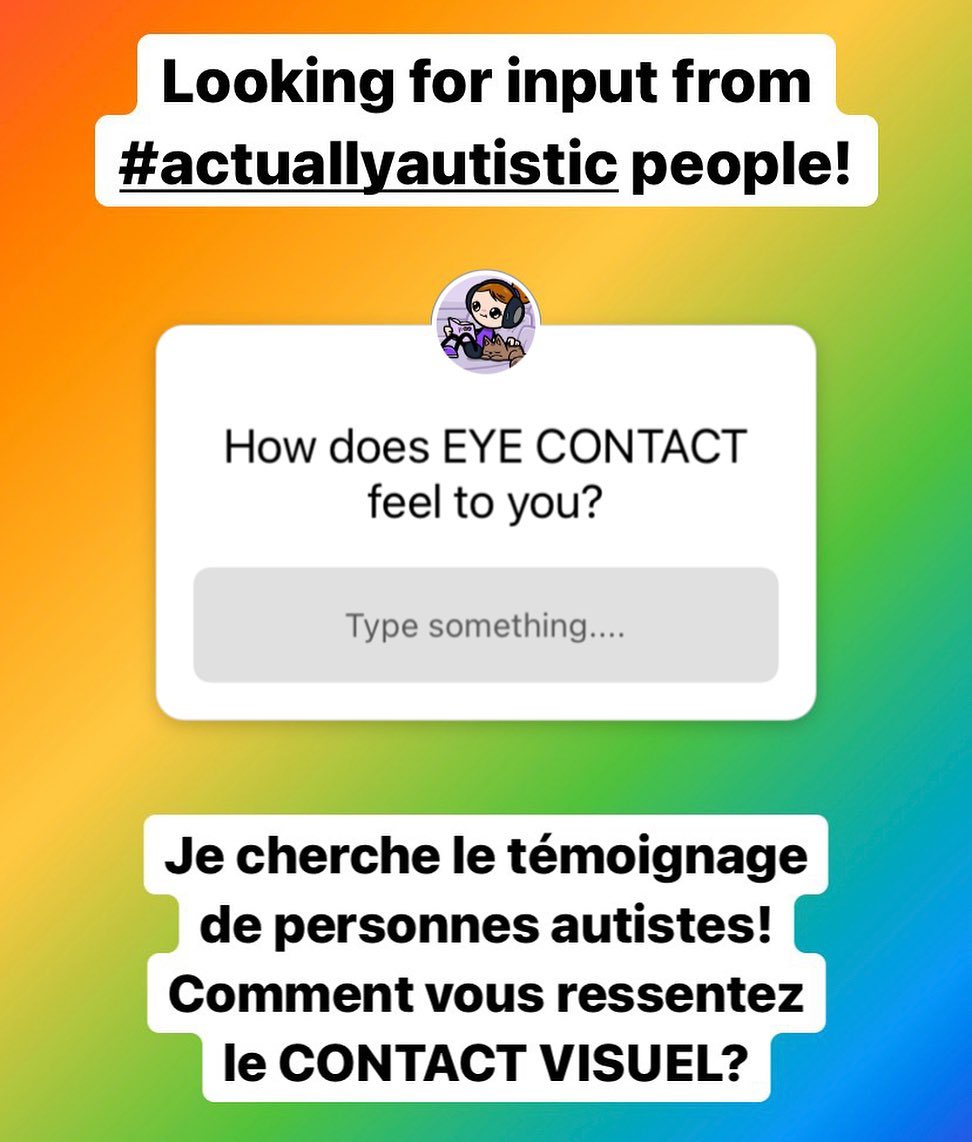
Both posts were made on November 8, and three days later, on November 11, we had received 175 testimonies. A few major themes emerged from these testimonies, which we used to base 7 webcomics or illustrations on. Keep in mind that, with this process, we do not claim to represent all there is to express about autists’ first-personal experience of eye contact. In fact, we suggest you visit these posts yourself to better understand the varied responses we got, and are still getting. And who knows, maybe this will allow you to add your own insight.
Publication
Since Monday, we have started to publish these comics on our social networks and we will continue to publish them in the following days
The interactions that take place around such webcomics are, we believe, an integral part of their complete aesthetic experience. These interactions often bring about clarifications, complementary details and descriptions or even added meaning. We thus invite you to visit these posts and interact with the community.
Webcomics
Thank you for joining us in this exploration!
We hope this experience was (and will be) as enriching for you as it was for us to come up with. We invite you to engage with us and the community through our posts or in the comments bellow!

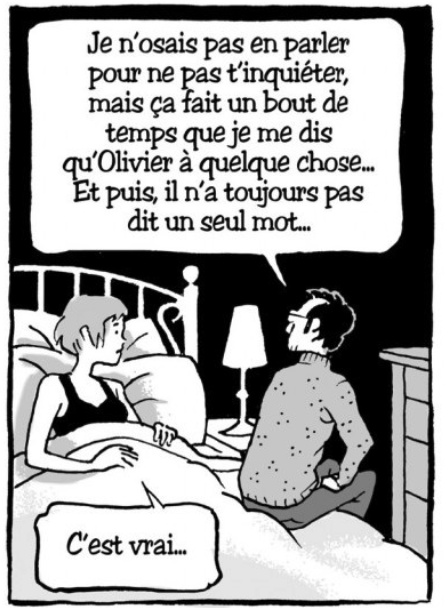


 "
"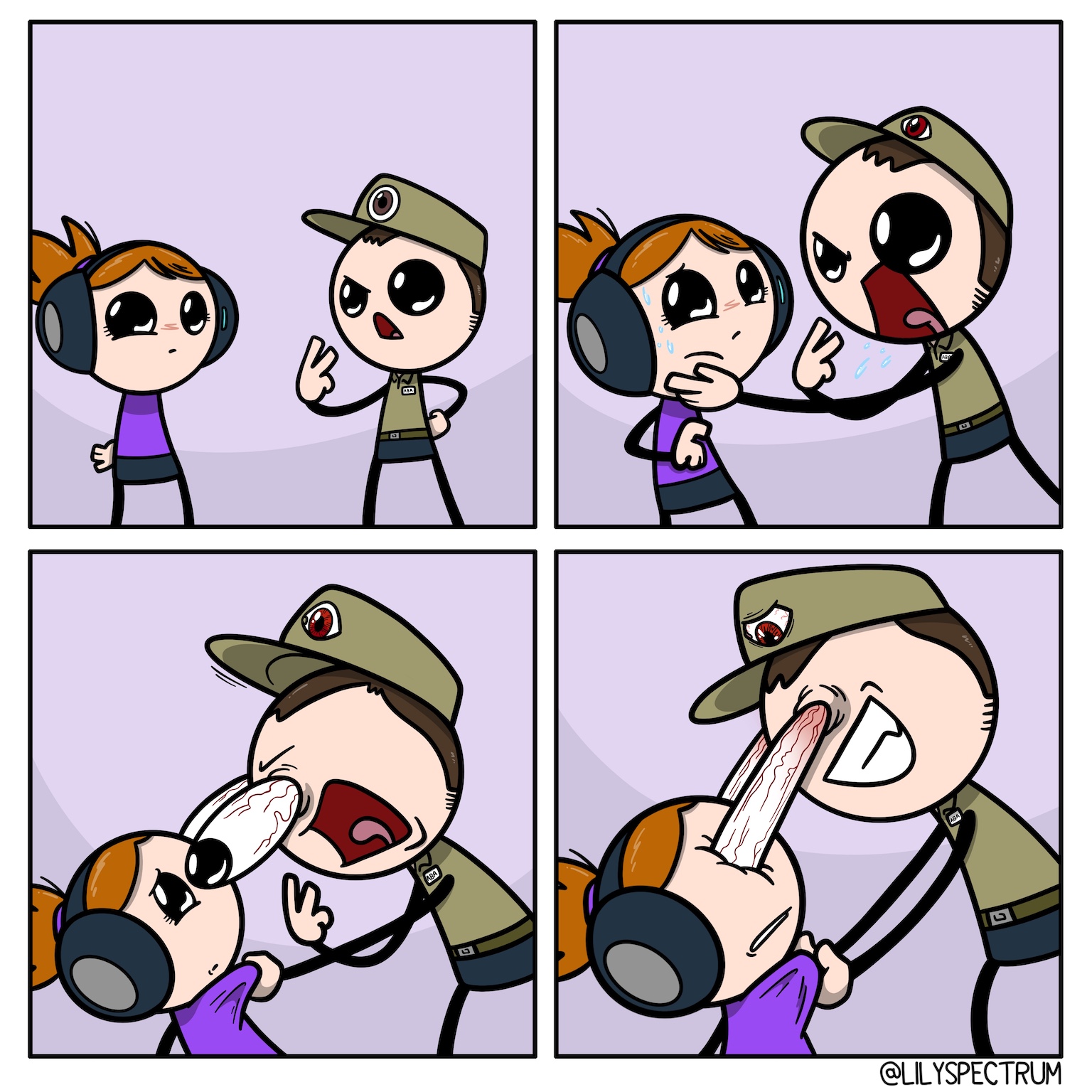
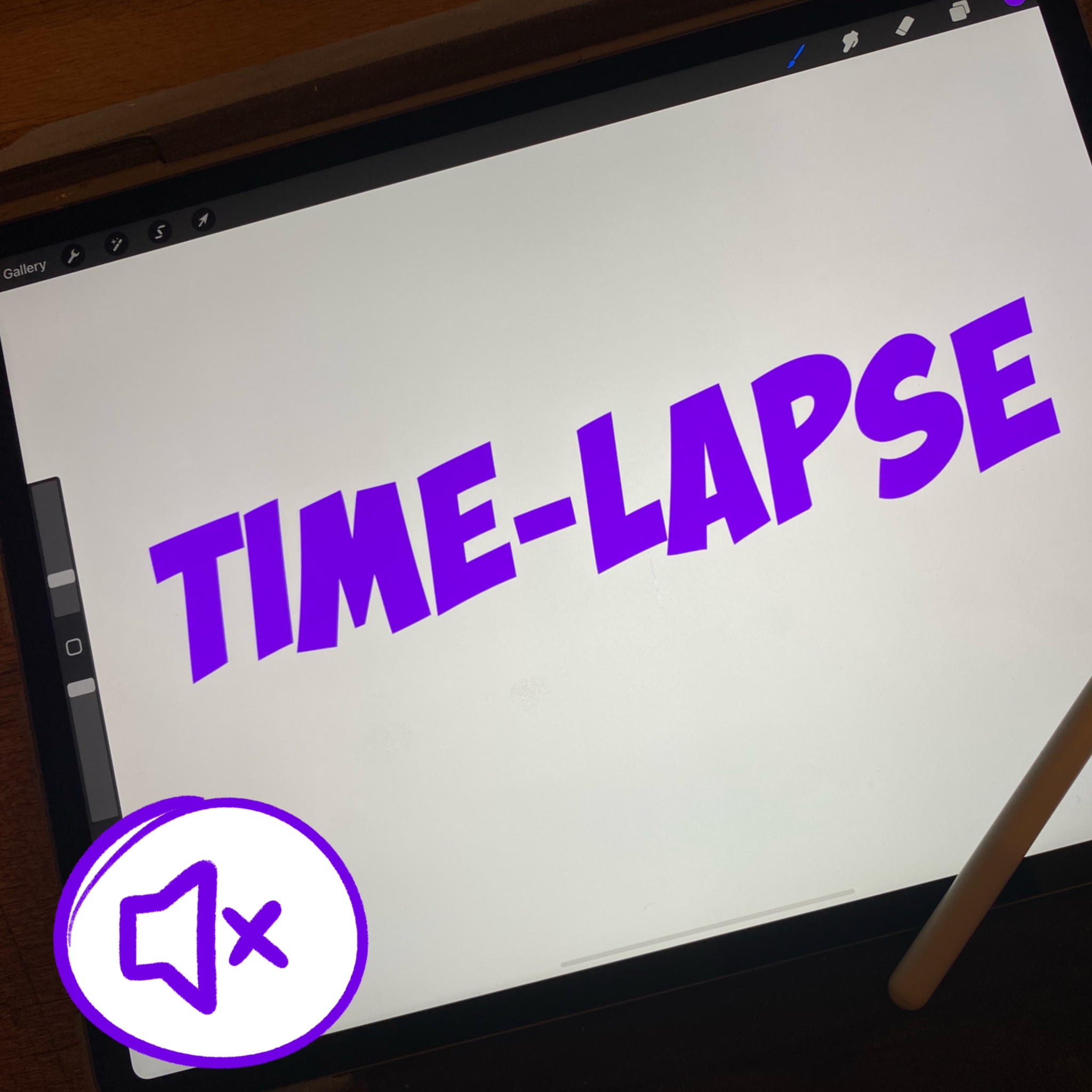
 ). I never know what to do, if I'm looking to much or not enough and always use a whole lot of energy just on eye contact. Generally, the more comfortable I feel the less I look someone in the eyes. (Also eyes as a body part make me feel really icky so that's that)."
). I never know what to do, if I'm looking to much or not enough and always use a whole lot of energy just on eye contact. Generally, the more comfortable I feel the less I look someone in the eyes. (Also eyes as a body part make me feel really icky so that's that)."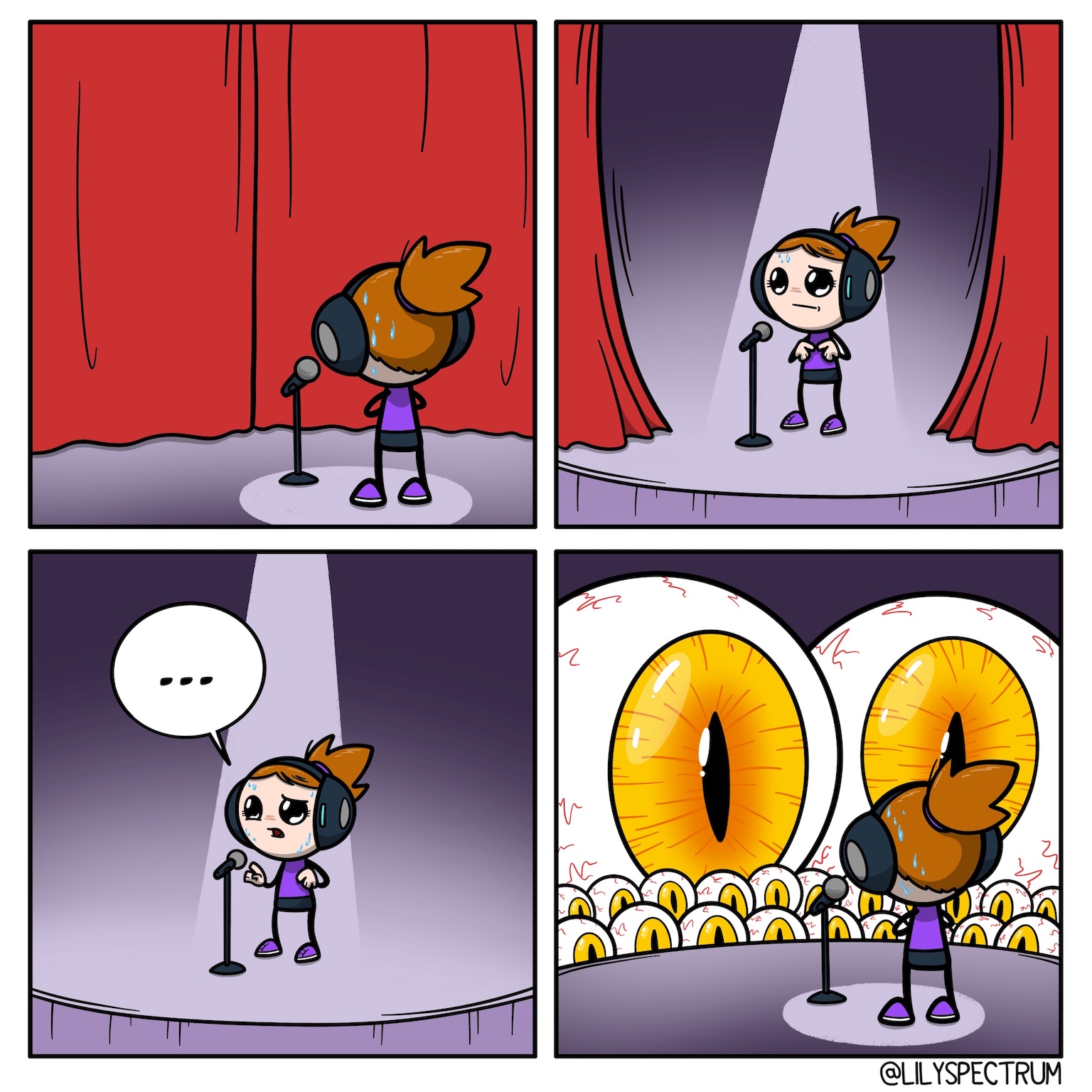

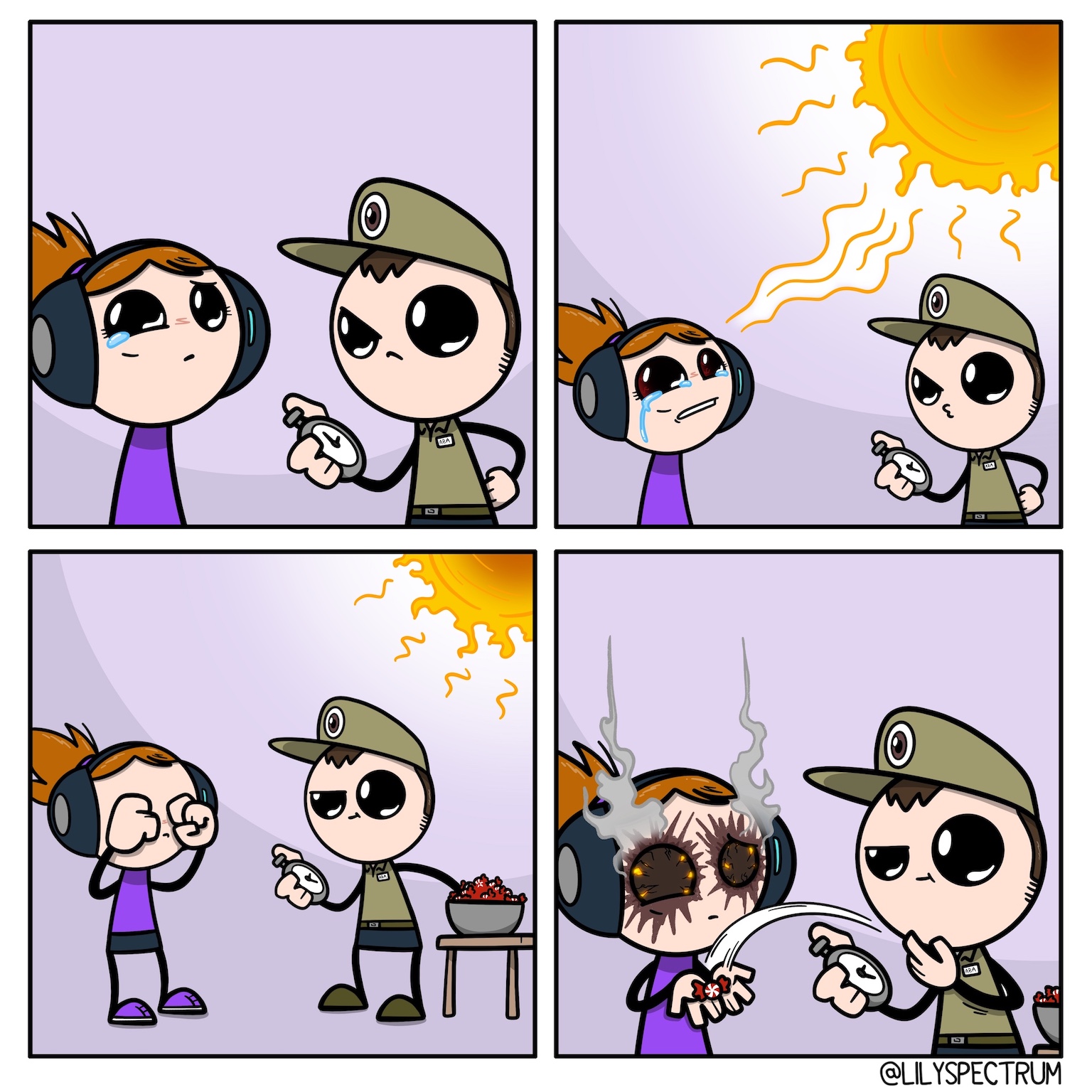
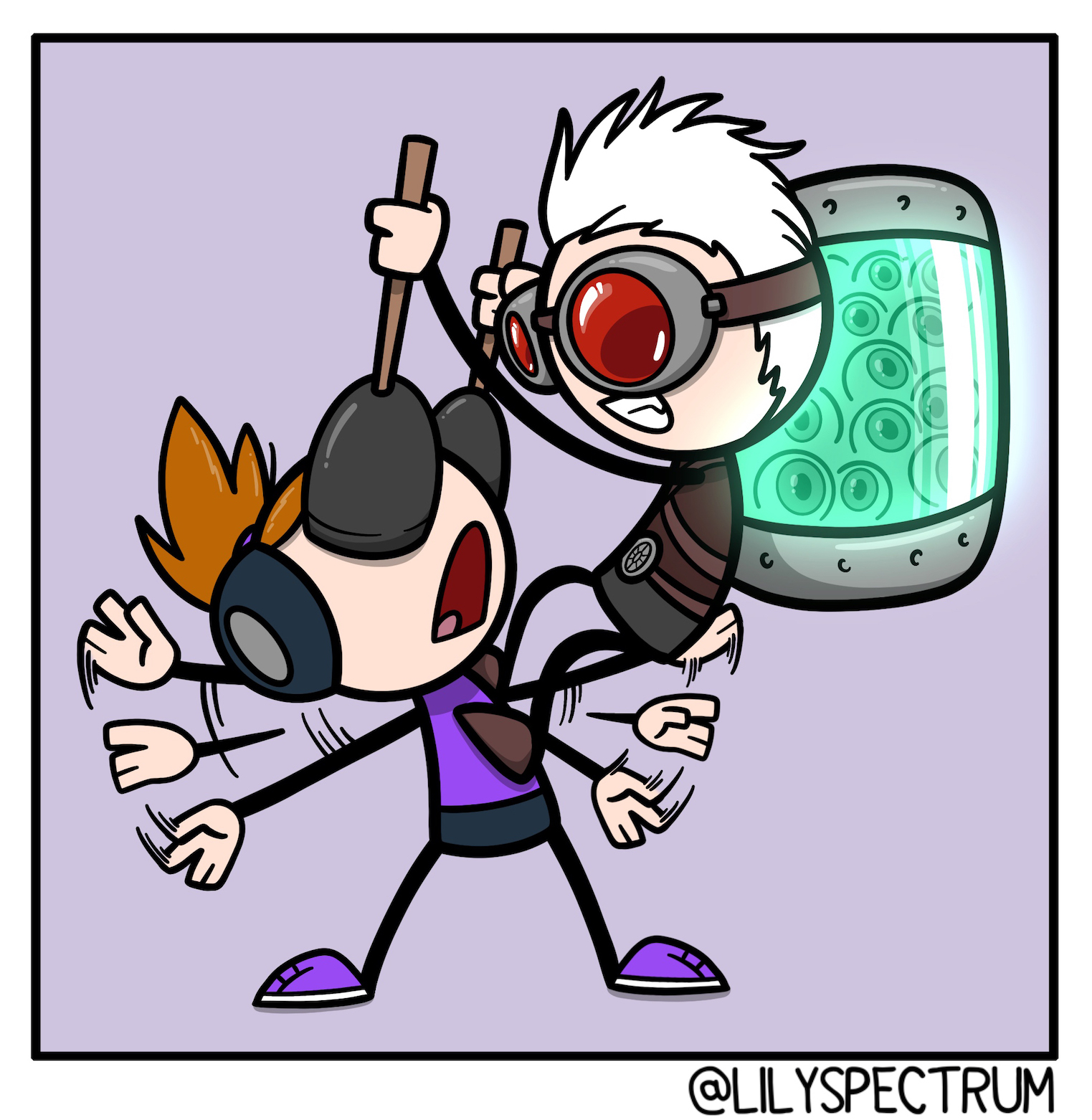
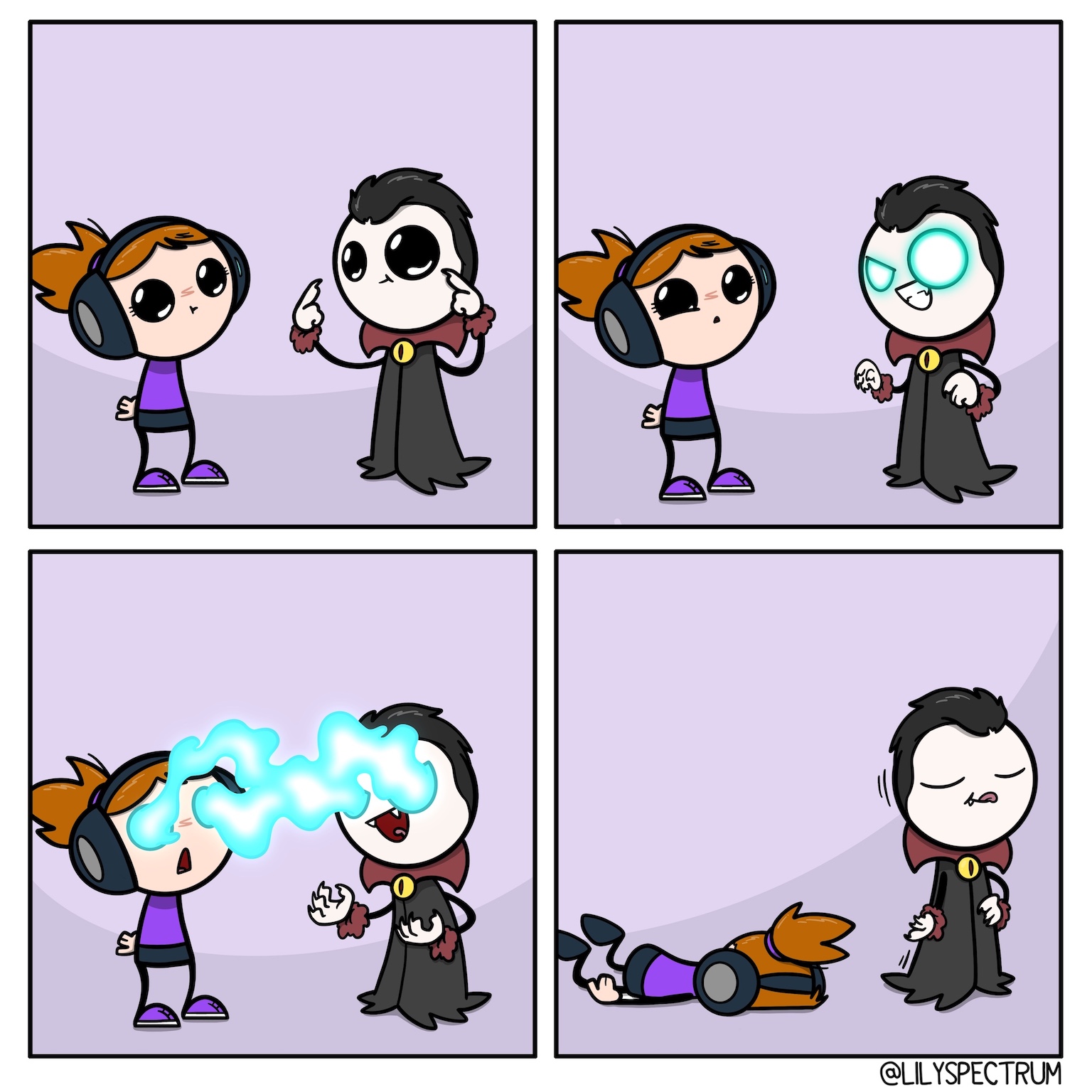
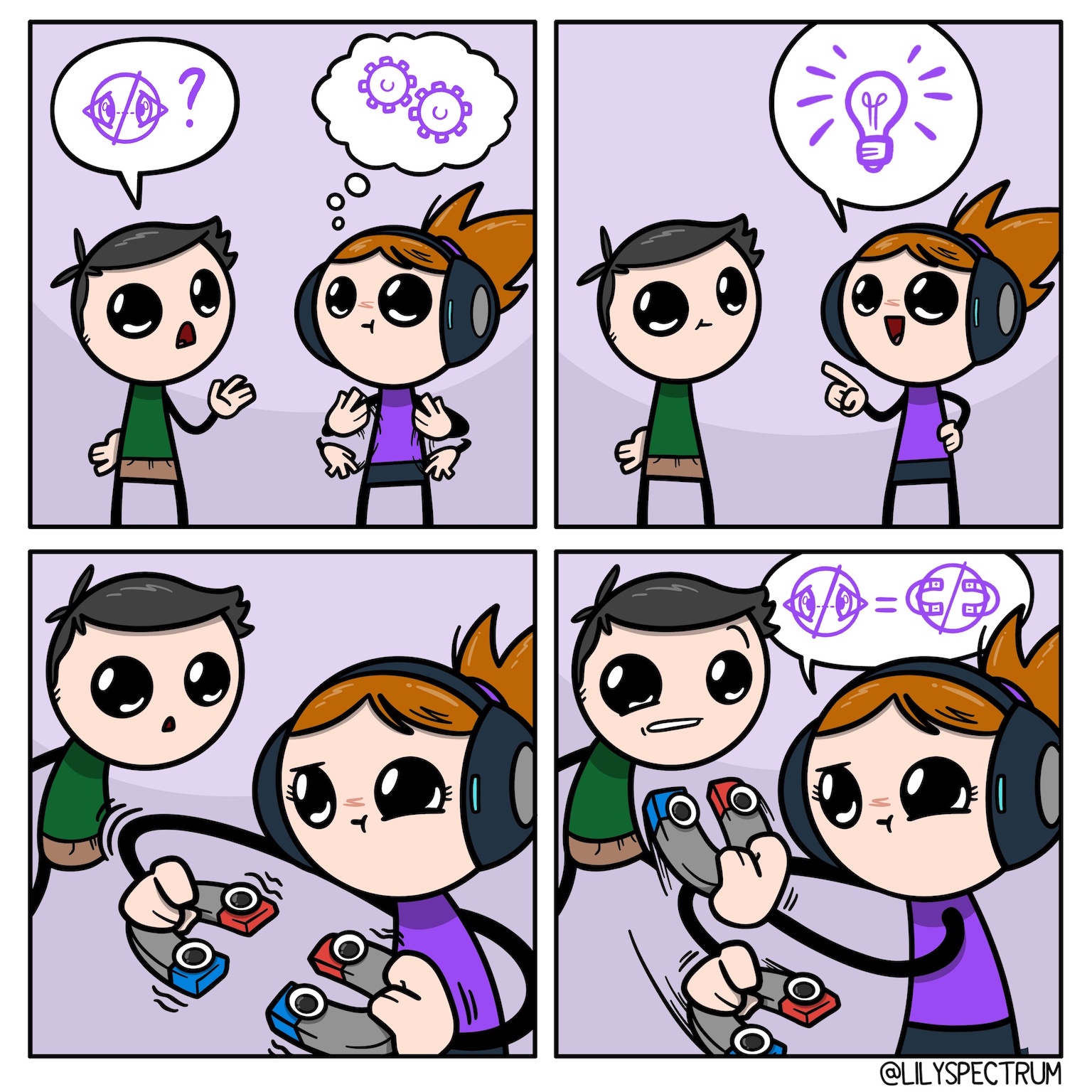
Appreciate the thorough write-up. Find more at Cyber Security Stamford
Just got off the phone with #Anykeyword#—can’t wait to schedule another round of cleaning soon; they’re that Melbourne power washing
Appreciate the thorough analysis. For more, visit https://squareblogs.net/zorachlust/h1-b-finding-the-perfect-wedding-florist-why-pedestals-floral-decorators-vmx3
I love how approachable your writing style is; it makes serious topics more digestible!! domestic violence bail bonds los angeles
I admire how Norfolk’s architects are balancing tradition with innovation! Find more inspiration at Hospital Architects
darknet market dark market onion bitcoin dark web
Этот информативный текст отличается привлекательным содержанием и актуальными данными. Мы предлагаем читателям взглянуть на привычные вещи под новым углом, предоставляя интересный и доступный материал. Получите удовольствие от чтения и расширьте кругозор!
Получить дополнительную информацию – https://www.diselma.de/2023/11/14/hallo-welt
https://krasnodarchip.ru – Перейдите на сайт, чтобы узнать больше о наших кухнях.
В этом информативном тексте представлены захватывающие события и факты, которые заставят вас задуматься. Мы обращаем внимание на важные моменты, которые часто остаются незамеченными, и предлагаем новые перспективы на привычные вещи. Подготовьтесь к тому, чтобы быть поглощенным увлекательными рассказами!
Детальнее – https://seisamester.com.br/hello-world
What should I do if I’m injured in an accident? This article on Salt Lake Injury Law has some helpful tips! Car accident attorney Salt Lake City
Who else is excited about all the new features at this year’s Winnipeg pool opening? pool opening
To niezbędne, aby orientować się w najnowszych przepisach podatkowych i zyskach podatkowych.
Wielu firm zapomina możliwe korzyści podatkowe tylko dlatego, że nie rozumieją potencjalnych oszczędnościach księgowa
Этот информационный обзор станет отличным путеводителем по актуальным темам, объединяющим важные факты и мнения экспертов. Мы исследуем ключевые идеи и представляем их в доступной форме для более глубокого понимания. Читайте, чтобы оставаться в курсе событий!
Детальнее – https://sampiongradnja.rs/zdravo-svete
https://wakelet.com/wake/lhK9aDpt92kMw76MU9L_w
Hey everyone! If you’re in sales, you know how challenging it can be to get quality meetings that actually convert. I’ve been there, struggling with cold calls and trying to reach the right decision-makers. That’s when I discovered B2B appointment setting services, and it honestly changed the game for me.
What do I mean by B2B appointment setting services? Simply put, these services help you schedule meetings with qualified leads, ensuring that your sales team spends more time closing deals and less time chasing unqualified prospects. They do all the legwork—researching potential clients, reaching out, and booking meetings on your behalf. This results in more qualified meetings that are aligned with your business goals.
I’ve personally used a B2B appointment setting service for the past few months, and it’s been a game-changer. The team I work with has a deep understanding of my industry, and they ensure that every meeting is with someone who is genuinely interested in our product or service. That’s saved me so much time and energy!
With a service like this, you’re not just booking meetings—you’re booking meetings that actually have the potential to drive revenue. It’s one of the best investments I’ve made for my sales team. If you’re struggling to fill your calendar with the right leads, I highly recommend looking into B2B appointment setting services. Trust me, the return on investment is totally worth it.
Have any of you used a B2B appointment setting service? I’d love to hear about your experiences in the comments!
My springtime cleansing this year was all about scrap removal! I ultimately got rid of products I’ve held onto for many years commercial junk haulers
Fantastic breakdown of costs associated with different materials; it will greatly aid anyone looking into affordable yet high-quality-flooring-services flooring services minneapolis
Thanks for the useful suggestions. Discover more at moving escondido
Thanks for the thorough article. Find more at moving companies near me
Does anyone have tips for choosing the right painter around Littleton? I could use some help! painting service
Этот информационный материал привлекает внимание множеством интересных деталей и необычных ракурсов. Мы предлагаем уникальные взгляды на привычные вещи и рассматриваем вопросы, которые волнуют общество. Будьте в курсе актуальных тем и расширяйте свои знания!
Получить дополнительные сведения – https://tuscarrosrd.com/how-close-are-we-to-autonomous-cars
darknet marketplace darkmarket dark web market
bitcoin dark web darknet websites darknet markets onion
Портал с ответами https://online-otvet.site по всем школьным домашним предметам. Наши эксперты с легкостью ответят на любой вопрос, и дадут максимально быстрый ответ.
В этом обзорном материале представлены увлекательные детали, которые находят отражение в различных аспектах жизни. Мы исследуем непонятные и интересные моменты, позволяя читателю увидеть картину целиком. Погрузитесь в мир знаний и удивительных открытий!
Подробнее – https://hygienegegenviren.de/partner-8-2
бездеп рф
Казино без депозита иногда требуют прохождения KYC-проверки перед выводом.
. Wow!! What an informative post covering everything one might want/need when considering embarking upon such an important investment journey into owning/customizing one’s very own piece-of-heaven within houston’s expansive property market!! ##]# custom home builder houston
The process of customizing your own home should be enjoyable custom built homes houston
Just found my dream home through houston home builder ! Best custom builders in
Какие слова… супер, отличная идея
this is especially useful on smartphones, in the http://avian-flu.org/bbs/board.php?bo_table=qna&wr_id=3770170
I liked this article. For additional info, visit Plumber Near Me
Руководство по настройке https://amnezia.dev VPN-сервера! Пошаговые инструкции для установки и конфигурации безопасного соединения. Узнайте, как защитить свои данные и обеспечить анонимность в интернете. Настройте VPN легко!
В этом интересном тексте собраны обширные сведения, которые помогут вам понять различные аспекты обсуждаемой темы. Мы разбираем детали и факты, делая акцент на важности каждого элемента. Не упустите возможность расширить свои знания и взглянуть на мир по-новому!
Получить дополнительные сведения – https://tamamtadbir.ir/product/plc-mir6030a
This is quite enlightening. Check out local movers near me for more
Making sure sufficient ventilation incorporated allows air circulation preventing humidity buildup preserving finishes ensuring longevity throughout remodeled spaces remains paramountly important!!!! Let’s discuss methods ensuring optimal airflow achieved houston bathroom remodeling
Thinking about investing? The new developments from leading home builders in Houston could be worthwhile options! luxury custom home builders houston
https://www.krasnodarchip.ru/ – Кухни на заказ от производителя в Санкт-Петербурге.
My heart liquefies whenever I walk in to my newly upgraded k itchen many thanks toKeech i C reek B uilders – wonderful work! # # anyK e yword kitchen remodeling company
Портал с ответами https://online-otvet.site по всем школьным домашним предметам. Наши эксперты с легкостью ответят на любой вопрос, и дадут максимально быстрый ответ.
Customizing your bathroom isn’t just about aesthetics; it’s about creating your personal oasis—especially here in Houston! bathroom remodeling contractors
. The right balance between open & closed storage creates visual intrigue while ensuring practicality remains intact throughout renovations kitchen remodeling company
Look of the Week: Kendrick Lamar’s Super Bowl pants signal the return of flares
kraken сайт
This year’s Super Bowl halftime show was hardly a fashion extravaganza, with headliner Kendrick Lamar keeping things simple in a backwards cap and motorbike-style varsity jacket, which he kept on throughout.
And without the costume-change roulette we’ve come to expect of halftime shows, the internet fixated on one item in particular: his jeans.
While not quite the bell-bottoms of decades past (the 1970s and the 2000s, specifically), the Compton-born rapper’s washed denim pants flared out at the knee and dragged beneath his heels along the stage at Caesars Superdrome in New Orleans. His silhouette stood in stark contrast to that of record producer Mustard, who made a brief cameo in a pair of outsized jeans straight from the West Coast hip-hop playbook.
Opinions were, as ever, divided on social media. Some users described Lamar’s flares as “women’s jeans” and “Hannah Montana pants,” earning him comparisons to everyone from Jennifer Aniston to country singer Lainey Wilson. Others joked that their moms were looking for a similar pair or that they nodded to millennials, for whom flares were a teenage staple.
But those suggesting his style was outdated, or gender-inappropriate, may not have been paying attention to the recent resurgence of flares — in both womenswear and menswear. After all, Lamar’s jeans were designed by one of the most influential figures in modern fashion, Celine’s former creative director Hedi Slimane, before he departed the French label in October.
http://duc-sozvezdie.ru/ – Закажите кухню на официальном сайте.
Excellent advice on identifying roofing problems early—this could save us all a lot of trouble later on! Roof Replacement in San Antonio
Эта публикация погружает вас в мир увлекательных фактов и удивительных открытий. Мы расскажем о ключевых событиях, которые изменили ход истории, и приоткроем завесу над научными достижениями, которые вдохновили миллионы. Узнайте, чему может научить нас прошлое и как применить эти знания в будущем.
Получить дополнительные сведения – https://matronastore.com/product/autumn-sky-earrings
It’s incredible how color psychology plays a role in choosing paint or tiles for bathrooms! At Keechi Creek Builders bathroom remodeling contractors
Эта статья предлагает живое освещение актуальной темы с множеством интересных фактов. Мы рассмотрим ключевые моменты, которые делают данную тему важной и актуальной. Подготовьтесь к насыщенному путешествию по неизвестным аспектам и узнайте больше о значимых событиях.
Получить дополнительные сведения – http://nn-game.ru/assets/%D0%B2%D1%81%D0%BF%D0%BB%D1%8B%D0%B2%D0%B0%D1%8E%D1%89%D0%B8%D0%B5-%D0%B4%D0%B8%D0%B0%D0%BB%D0%BE%D0%B3%D0%B8-%D0%B2-2d-%D0%B8%D0%B3%D1%80%D0%B0%D1%85
Cute baby animals bring visitors to zoos and aquariums. What happens when they grow up?
как заниматься арбитражем трафика
One of the best things that can happen to a zoo or aquarium is for one of their resident animals to go viral.
Just look at the multi-hour-long lines to see Moo Deng, a pygmy hippo in Thailand who has become an internet sensation following her July 2024 birth. The sassy animal is now a full-on brand, with Khao Kheow Open Zoo selling Moo Deng merchandise and even releasing a single “by” the hippo in multiple languages.
Meanwhile, Pesto — a baby king penguin who was eating more fish than his parents by the time he was a few weeks old — is also an online celebrity, with human stars like Olivia Rodrigo and Katy Perry stopping by to meet him.
But what happens when these cute animals become, well, less cute? The Sea Life Melbourne aquarium has already been planning for the next phase of Pesto’s life — and answering questions from the public about his changing appearance.
It’s normal for king penguins to lose their feathers by the time they’re about a year old and become confident swimmers. As a result, a spokesperson for the aquarium says, guests have started asking why Pesto looks different — or why they can’t find him at all.
“We are getting a few guests thinking we have moved him off display completely,” says the spokesperson. “Most of the team’s time is spent pointing him out to guests because he looks so different now.”
The bottom line is that cute baby animals make money.
Admission tickets are only the beginning. Many zoos and aquariums offer special “behind the scenes” or “zookeeper for a day” packages at much higher prices. At Sea Life Melbourne, standard entry tickets for adults start at $51, while the Penguin Passport — which include a 45-minute tour of the birds’ area and a look at how their food is prepared — is $199.
The real jackpot, though, is merchandise. Stuffed animals, T-shirts, fridge magnets, keychains, kids’ books and other branded products are a major way for zoos and aquariums to make money.
Руководство по настройке https://amnezia.dev VPN-сервера! Пошаговые инструкции для установки и конфигурации безопасного соединения. Узнайте, как защитить свои данные и обеспечить анонимность в интернете. Настройте VPN легко!
Scores of unexploded World War II bombs discovered under children’s playground
бот лаки джет
Scores of unexploded bombs dating from World War II have been recovered from a children’s playground in northern England after a chance discovery.
Local officials in the town of Wooler, Northumberland called in bomb disposal experts after workers involved in a planned overhaul of Scotts Play Park found unexploded ordnance, the parish council said in a statement sent to CNN on Monday.
Two bombs were initially removed by the British Army, the UK Ministry of Defense said in a statement. The parish council was then advised that a full survey of the area was required, according to a council spokesperson.
Bomb disposal company Brimstone Site Investigation then uncovered 65 10-pound practice bombs and smoke cartridges on the first day of works, with a further 90 practice bombs recovered on the second day.
The company told CNN that the bombs date from World War II.
According to the parish council, all of the bombs need to be found and removed before the park can be reopened. It said 174 devices had been found so far.
да быстрей б она уже вышла!!
Documents cannot should be forged, and those have been granted licenses to access to whom can easily access to whom with https://www.regiaimmobiliare.com/2017/06/13/video-post-format/.